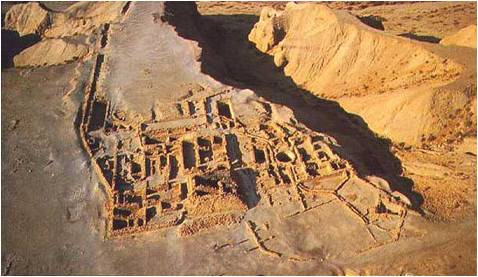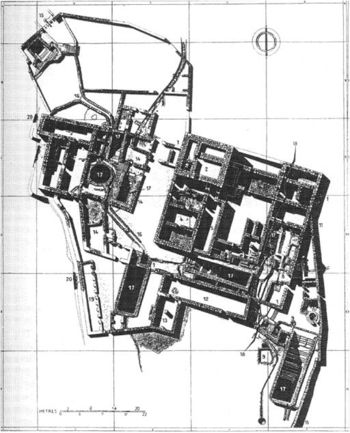Qumran
Qumran / Khirbet Qumran is an archeological site located in the West Bank on a dry plateau about a mile from the northwestern shore of the Dead Sea, in the area in which most of the Dead Sea Scrolls were found.
The settlement was constructed during the Hasmonean period (late 2nd century BCE) and was occupied until 68 BC, when it was destroyed by the Romans during the Jewish War, and never rebuilt. Most scholars see a close connection between the scrolls and the settlement; Qumran was the home of a sectarian community who collected the scrolls and authored some of them.
Archeology of Qumran
The site had been known to European explorers since the 19th century. The ruins were commonly interpreted as those of a fort.
Interest in the site arose in the late 1940s when the first Dead Sea Scrolls were found in nearby caves. The site was extensively excavated in the 1950s by archaeologists under the direction of Roland de Vaux. De Vaux interpreted the ruins as the home of a community of Essenes who lived a quasi-monastic life devoted to prayer and the study and writing of religious documents.
Main Gate
Tower
Scriptorium
Roland de Vaux identified one of the excavated rooms as the Scriptorum of the community, as several inkwells were found there. Some of the stone furniture that collapsed from the second floor was tentatively reconstructed as "tables" and "benches" used by scribes to write the scrolls.
Assembly Hall (Refectorium)
A large rectangular room at the southern section of the settlement was identified by de Vaux as an assembly hall (or refectorium). Several elements advance such an identification. First of all the dimensions, the presence of a water channel (which would have facilitated the cleaning) and a miqveh (ritual bath) directly outside the room (which would have facilitated the rituals of purification.
Kitchen
Pantry
Water System
Qumran had a quite elaborate water system, a complex network of aqueducts and cisterns. In the dry and hot environment, water was necessary for drinking and bathing, but also to satisfy the purity concerns of the community.
Toilet
Cemetery
A large cemetery, located 30-40 meters east of the main living area, has been found at Qumran. The analysis of the cemetery is complicated by the fact that the cemetery was later used by Muslim Bedouins. However, the old cemetery clearly distinguishes itself for some unique features:
- All tombs are arranged in ordered rows, with a north-south orientation.
- There are no family tombs but only individual tombs.
- The absence of women and children under the age of 16 demonstrates that Qumran was home to a male-oriented religious community.

